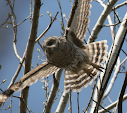
This Mallard was different from the many others around because it was predominantly brown on its back and lower sides. In March, male Mallards have gray backs and undersides. Also, this Mallard seems to have an incomplete neck ring.

Almost fittingly, there have been a few discussions of Mallard hybrids running on the COBirds mailing list over the past week. I began to wonder if this bird may have a bit of something else in it. After a bit of searching online and in field guides I am leaning away from it, but would welcome input from anyone who has seen similar coloration in Mallard drakes.

Beyond the obvious difference I see some very strong Mallard features in this bird. The tail coverts have the Mallard curl, and in flight are offset by the white tail feathers. The speculum (the colored patch seen on a Mallard's outstretched wing), of a Mallard can range from green to violet depending on the light, and more specifically for identification is bordered on both the leading and trailing edges by a relatively broad white band. This bird clearly shows the correct pattern for a Mallard.

After reading and looking at other images out there in Internet-land I am fairly certain that this is a Mallard who for some reason or other either did not complete or prematurely began a molt. I don't have anything at hand to cite, but believe that if birds are confronted with a hardship while molting, their molt process may stop mid-stream. It would then pick back up on the next cycle to get them back to their correct appearance. This bird also may be a sub-adult, although some features like the head seem very complete for an adult.
I have reached out to others to confirm or contradict my conclusion, and welcome any comments to that effect here. Finding the "one of these things is not like the others" in nature is always interesting. Learning what may have caused that one to be different is even more rewarding.
Of course, any consensus or update will be added to the post.

No comments:
Post a Comment